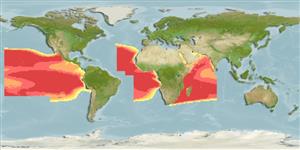Actinopterygii (ray-finned fishes) >
Aulopiformes (Grinners) >
Scopelarchidae (Pearleyes)
Etymology: Rosenblattichthys: Because of Richard Rosenblatt, ichthyologist os Scripp Institution of Oceanography in La Jolla; hubbsi: Named after Carl L. Hubbs in recognition of his numerous contributions to ichthyology (Ref. 40783).
Environment / Climate / Range
Ecology
Marine; pelagic-oceanic; oceanodromous (Ref. 51243); depth range 0 - 657 m (Ref. 58302). Subtropical, preferred ?
Atlantic, Indian and Pacific: in subtropical waters; unknown from the central South Pacific and the Mediterranean Sea. Eastern Central Atlantic: known from only 3 stations, ca 24°N to 2.5°S, none from the Gulf of Guinea, Benguela Current area.
Size / Weight / Age
Maturity: Lm ? range ? - ? cm
Max length : 14.5 cm SL male/unsexed; (Ref. 10755)
Short description
Morphology | Morphometrics
Dorsal
spines
(total): 0;
Dorsal
soft rays
(total): 8-9;
Anal
spines: 0;
Anal
soft rays: 23 - 25;
Vertebrae: 49. Color in alcohol: more or less yellow-brown, with intense pigmentation outlining scale pockets; pectoral and pelvic fins covered with small, scattered melanophores; black streak bordering anterior margin of eye (Ref. 6601).
Oceanic, mesopelagic or bathypelagic species (Ref. 6601). The single known adult (holotype) was taken in haul between 657 to 0 m; most larvae have been taken in haul in the upper 500 m and in waters as shallow as 60 m. Probably feeds on other midwater fishes (Ref. 6691). Presumed to be synchronous hermaphrodites (Ref. 10755). Also Ref. 58302.
Life cycle and mating behavior
Maturity | Reproduction | Spawning | Eggs | Fecundity | Larvae
Johnson, R.K., 1990. Scopelarchidae. p. 393-397. In J. C. Quero, J. C. Hureau, C. Karrer, A. Post and L. Saldanha (eds.) Check-list of the fishes of the eastern tropical Atlantic (CLOFETA). JNICT, Lisbon; SEI, Paris; and UNESCO, Paris. Vol. 1. (Ref. 10755)
IUCN Red List Status (Ref. 115185)
CITES (Ref. 94142)
Not Evaluated
Threat to humans
Harmless
Human uses
Fisheries: of no interest
More information
Common namesSynonymsMetabolismPredatorsEcotoxicologyReproductionMaturitySpawningFecundityEggsEgg development
Age/SizeGrowthLength-weightLength-lengthLength-frequenciesMorphometricsMorphologyLarvaeLarval dynamicsRecruitmentAbundance
ReferencesAquacultureAquaculture profileStrainsGeneticsAllele frequenciesHeritabilityDiseasesProcessingMass conversion
Tools
Special reports
Download XML
Internet sources
